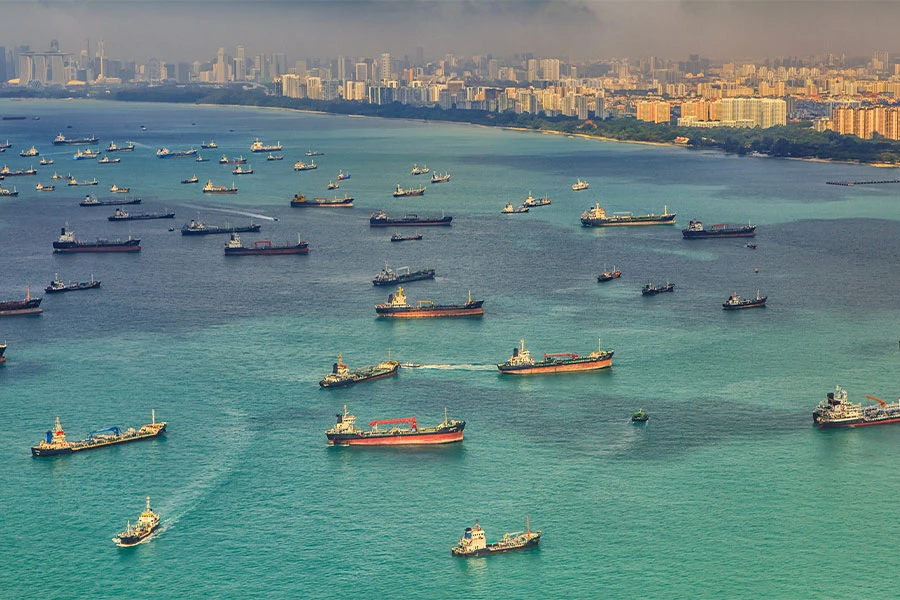Singapore's port is currently facing significant congestion, causing notable disruptions in the global supply chain. We shall expect the primary root causes of this congestion include:
Geopolitical Tensions and Supply Chain Disruptions: The ongoing conflict in the Red Sea has forced many vessels to reroute around the Cape of Good Hope, leading to off-schedule arrivals and vessel bunching at the port. This has disrupted the regular flow of shipping schedules and increased the number of container vessels arriving unpredictably (The Maritime Executive).
Increased Container Volumes: There has been an 8.8% increase in container volumes handled by Singapore’s port in the first four months of 2024 compared to the previous year. This surge is partly due to shipping lines discharging more containers at Singapore to catch up with their schedules, resulting in more containers being handled per vessel (Portcast Platform).
Global Trade Dynamics: The recent increase in US tariffs on Chinese goods has triggered a rush in shipping activities, exacerbating the congestion as exporters hurry to send their products before tariff deadlines. This has added pressure on key transit ports like Singapore (Portcast Platform).
IMPACTS OF THE CONGESTION

Contact for more information
Extended Waiting Times: Container vessels are now facing waiting times of up to seven days for berthing, a significant increase from the usual half-day wait. This has led to around 450,000 TEU (twenty-foot equivalent units) being stuck and waiting to be berthed (Portcast Platform).
Increased Freight Rates and Transit Times: The congestion has resulted in longer transit times and an increase in freight rates. These disruptions are placing upward pressure on shipping costs and have led to equipment shortages (Seatrade Maritime News) (The Straits Times).
Global Supply Chain Disruptions: As Singapore is a major transshipment hub, the congestion has had a ripple effect on global supply chains. Some carriers have started to skip calls to Singapore and Port Klang, causing increased volumes and delays at downstream ports (Portcast Platform).
MITIGATION MEASURES AND OUTLOOK
Reactivation of Older Berths: PSA Singapore has reactivated older berths and yards at the Keppel Terminal to increase capacity. This measure has boosted the weekly handling capacity from 770,000 TEU to 820,000 TEU (Seatrade Maritime News).
Collaboration with Shipping Lines: The Maritime and Port Authority of Singapore (MPA) and PSA are working closely with shipping lines to optimize arrival schedules and berth planning. This includes efforts to minimize delays and manage the increased demand on container handling.
Expansion Projects: Additional berths are set to open later this year at Tuas Port, which will further expand capacity and help alleviate congestion in the long term (Hellenic Shipping News).
Oil spill caused by Dredger incident with bunker vessel: On 14 June 2024, a dredging boat hit a bunker vessel and 400 tons of oil are spilled into the sea affecting shorelines. As of 16th June 2024, no oil slick has been reported in the Traffic Separation Scheme (TSS) of the Singapore strait, with navigation traffic and port operations are unaffected. However, this is not to be taken for granted and the various authorities are monitoring the situation closely and containment actions are carried out since. (The Straits Times)
The outlook for Singapore's port congestion remains challenging, especially with the peak shipping season approaching. Continued disruptions are anticipated, and freight rates may see further increases. Efforts by PSA and MPA to manage and mitigate the impact will be crucial in stabilizing the situation in the coming months (Portcast Platform) (The Loadstar).
The current situation is extremely fluid, and events are evolving constantly by the world events which we at Bertling are committed to work with our clients to mitigate these issues to minimize the impact of the project supply chain.
LOOKING FOR AN ALTERNATIVE TO SEA FREIGHT?
Check out our airfreight services.
